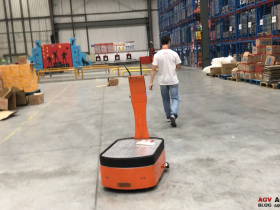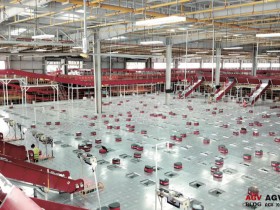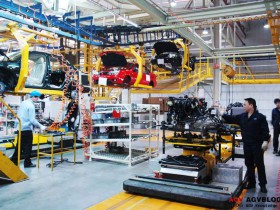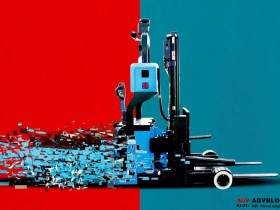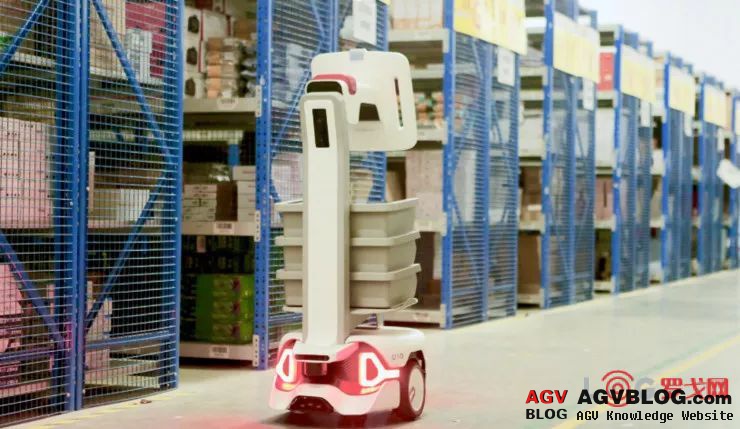
When it comes to warehousing robots, most people think of AGV (Automated Guided Vehicle) instead of AMR (Automated Mobile Robot). In fact, many people don't even know what the latter means, let alone the difference between it and AGV. Jiang Chao firmly believes that AMR is the next-generation warehousing robot product that will replace AGV.
Connect with warehouse robots
Jiang Chao is the founder and CEO of Juxing Technology , a warehouse robot company . Before founding Juxing Technology, he had a very glorious career experience: studying abroad, after graduation he worked for Motorola, NVIDIA and other international well-known enterprises. After returning to China, he served as the main person in charge of a famous robot project ... However, all this is related to logistics Industry-independent.
Jiang Chao's association with the logistics industry began with a dinner in Tianjin. On the table, a friend who did system intelligent planning in a logistics company affiliated to a household appliance giant complained to him, "The company's warehouse has a very low level of informationization and automation, and intelligent planning cannot be done at all."
A friend showed Jiang Chao a report about a logistics robot company abroad, which aroused his interest. At that time, Jiang Chao's service robot project encountered some bottlenecks. Jiang Chao believes that service robots cannot bring direct productivity and lack rigid requirements, which is not a good business. When he went on a business trip around the world, he often saw some hotel service robots sitting idle and covered with dust, which made him feel heartache. "I don't want his product to be in this form."
Warehousing robots seem to be a good direction.
Last November, Jiang Chao visited Tianjin once. At that time, it was " Double 11 ", the company's friend's company orders increased sharply, the warehouse was too busy, and a lot of temporary workers were invited from outside. Because of the high demand, temporary workers need to be recruited from far away and transported by bus. After the temporary workers are in place, they wait for the assignment in the cold wind outside the warehouse, and then enter the warehouse to pick the goods. After finishing the day's work, they returned to the same place, waited for the cash to settle their wages, and then returned by bus. This scene made Jiang Chao suffer a huge impact, "This is far from what I imagined China logistics, I think the robot I made should help."
AMR is replacing AGV
Of course, being a warehousing robot cannot be based on blood, Jiang Chao has conducted very detailed market research for this. He found that in the Japanese and North American markets, AMR is gradually replacing AGV as the new trend of warehousing robots. Data from market research institutions show that in the first half of 2018, AMR's profit increased by 57% year-on-year, while AGV's profit decreased by 43% year-on-year. In the Asia-Pacific region, the number of AMR is relatively small, but the growth is very rapid, with a growth rate of up to 129%.
The difference between AMR and AGV is that the former itself has powerful computing power, it can sense the surrounding environment through sensors and make corresponding decisions; while the latter is just a large-scale actuator, and every move depends on the scheduling of the central control system. "AGVs produced by companies such as Kiva and Jizhijia also have certain computing capabilities, but they still cannot be separated from the central control system, and their flexibility is very limited," Jiang Chao introduced.
Another advantage of AMR is that it is a more cost-effective solution. AMR does not require wires, magnetic strips or costly modifications to the building infrastructure. It starts faster and costs less, and it will not cause production interruption during deployment. It can almost immediately improve production efficiency. This makes it more suitable for China's unique market soil.
In the past two years, Jiang Chao has inspected many warehouses in various regions of China. He found that the basic conditions of China's warehouses are relatively poor, the ground settlement is severe, and the ground is very uneven, even cracked. "This kind of warehouse can't use AGV at all, but AMR can, because it has good barrier-crossing ability and adaptability."
The high initial investment of AGV is also unbearable for Chinese companies. According to market research data, Jiang Chao estimated that every 10,000 square meters of traditional warehouse transformation with AGV requires an initial investment of about 5 million yuan, which does not include the purchase cost of robots. To a domestic electricity supplier giant, for example, Jingdong standard warehouse area is usually around 20,000 square meters, which means that each transformation of a warehouse needs at least 10 million of investment, and so Jingdong warehouse at more than 1000.
In addition, adopting the AGV scheme also requires the transformation of the shelves, reducing the height of the shelves from 2.7 meters to 1.8 meters. There must also be space reserved for the AGV in the middle of the warehouse. The utilization rate of the space is not high in the plane or vertical dimensions. The B2C business model also determines that the enterprise's warehouse cannot be too far away from the big city, and must be developed around Beijing, Tianjin, Hebei, the Yangtze River Delta and the Pearl River Delta. The land in these areas is expensive, and it is a heavy burden on enterprises.
"The reason why Amazon can use the AGV program is because the US national situation is exactly the opposite of China. Their land is cheap, but their labor is expensive. And Amazon is the only one in the US e-commerce field. Less competitive pressure allows it to allocate its initial investment to The next ten years. "Jiang Chao explained.
In Jiang Chao's view, the AGV path is almost impossible in China because its target customers are "essentially non-existent."
Technical barriers of AMR
The essence of AMR is robot, and robot technology is a comprehensive technology, including algorithm, system software , mechanical hardware and electronic circuit , each part is very important. "If you only achieve ninety points for each item, it may not even reach the passing line when combined." Very few companies can master these four technologies at the same time, which creates a natural moat for AMR.
In all functional links of AMR, navigation is the top priority. The core of navigation is to answer three questions: 1. What is the position and orientation of the robot; 2. Where and how does the robot go? In the end, these three problems can be attributed to a little positioning. "Who can position well will gain an advantage in this competition."
Juxing AMR's navigation system uses a multi-sensor fusion solution. Multiple sensors on it will measure the same object at the same time. It is like having two thermometers in a room, one is a mercury thermometer, and the other is an electronic thermometer. The readings of the two thermometers usually have some differences. Torch Star needs to use a set of specific algorithms to comprehensively process these readings to get a value that is closest to the true value.
As far as this dimension is concerned, Juxing, Jizhijia, Kuicang and other AGV companies use two completely different sets of technology systems, which are "almost two generations behind." Therefore, Jiang Chao never regards these companies as competitors. "I think that scorn is a terrible competitor. They have a deep sedimentation in machine vision and have a strong soul. Last year, they acquired Iris. There is a strong body. "
Another core technology of AMR lies in the distributed control system. Unlike AGV, AMR does not require a central control system to issue orders to it, but can make autonomous decisions based on the surrounding environment. The division of labor in an AMR cluster is divided into two links:
In the first link, the cloud service docks with the customer's order management system, disassembles the order into tasks that the robot can understand, and then packages and transmits it to any robot in the cluster through the 4G network.
In the second link, the robot receiving the task package will synchronize the task package to all robots in the cluster through a similar point-to-point WiFi transmission technology. Then the robot will pick up the task according to its position.
The advantage of this is that it can reduce the frequency of communication between the robot and the cloud, reduce the requirements on the network, and reduce the burden on the cloud.
However , there are two major technical difficulties in this scheme: First, there is a distance limitation between the point-to-point transmission between the robots, which will cause a certain delay, which will cause a burden on the system;
As long as these two problems are solved, the advantages of distributed control systems are obvious. Just like a company, the boss only needs to issue tasks to the following employees, and the employees will coordinate independently. After the tasks are completed, they will be reported to the boss in a unified manner, which is very efficient and flexible.
The art of time difference
At present, Juxing has successfully launched its first product Syrius AMR.
"Juju AMR" is 1.2 meters high, 0.6 meters long and 0.42 meters long, 45 kilograms in weight, and 50 kilograms in maximum load. From top to bottom, the components are the base, the pallet carrying the goods, and the tablet for human-computer interaction. , Among them, the tablet can support the scanning of goods and the query of order status.
In terms of battery life, "Juxing AMR" is equipped with a 24V / 45Ah lithium battery, which can work continuously for 8 hours under the condition of 25kg standard load. At the same time, it also supports automatic charging and quick battery replacement, which can be fully charged in 2 hours.
"Juxing AMR" is currently being piloted at two 3C warehouses located in North China and East China of JD Logistics. In addition, Syrius has determined to cooperate with a domestic forklift manufacturer and reached a cooperation intention with a system integrator in Japan to provide a software interface as part of its e-commerce solution.
For his own technology and products, Jiang Chao is very confident. He believes that startups must challenge the big companies with something new, which may be a business model or a technological advantage. Ju Xing's first move is technical advantage.
But Jiang Chao also knew that technological superiority would disappear one day, and competitors would eventually understand the mystery. "So the key lies in how to make good use of the time difference, and before your opponent catches up, use other means to magnify your advantage. "
For the future, Jiang Chao thought very clearly, "We launched" Justar AMR "seems to be a result, but all this has been previewed many times like playing chess, divided into several steps, how to go each step, the opponent will have What kind of reaction did we think very clearly in the early stage. "
If you have to find a problem that Chao Chao is worried about, it is "do not need such a good technology to do AMR." "I'm worried about bad money driving out good money," Jiang Chao said.

